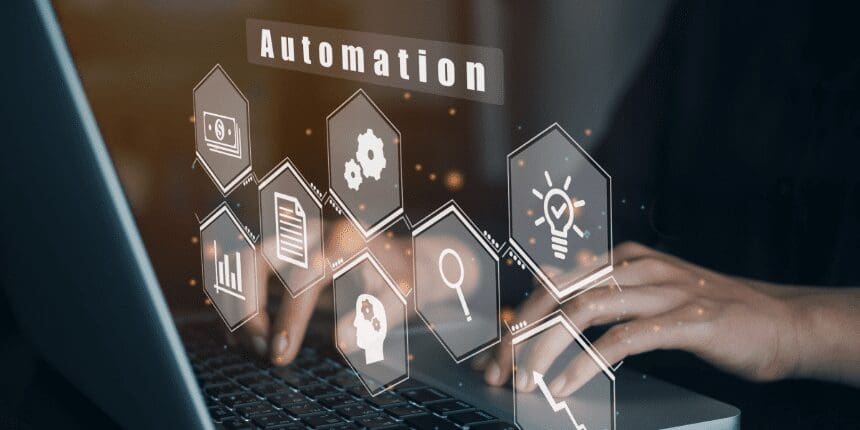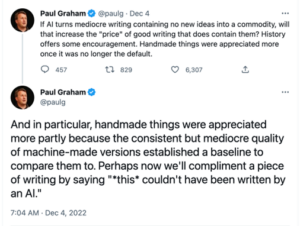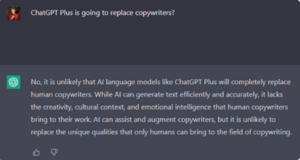
Navigate an unpredictable landscape with actionable, data-driven strategies tailored for your business from the brand down to the local level.

Let’s get straight to the point: Artificial Intelligence (AI) is a rapidly growing field that is set to revolutionize the way we live and work. While AI undoubtedly has the potential to solve many of the world’s problems, it has also created a paradox that we must address: AI is both a solution and a problem.
Graphic: Artificial intelligence: The simulation of intelligent behavior in machines that can learn from their experiences and perform tasks that would typically require human intelligence.
On the one hand, AI could conceivably solve some of the world’s most significant problems. It could help us combat climate change by analyzing data and identifying ways to reduce carbon emissions, cure diseases by analyzing large amounts of medical data and identifying new treatments, improve transportation systems by making them more efficient and reducing traffic congestion, or help us make better decisions in fields such as finance and education, where large amounts of data need to be analyzed to make informed choices. The potential uses of AI are vast and varied, and we have only begun to scratch the surface of what it can do.
On the other hand, AI also has the potential to create new problems. One of the most significant concerns is that AI could displace workers in many industries as machines become more intelligent, performing tasks that were previously done by humans. This could lead to significant job losses in many sectors, causing economic and social upheaval. AI could also exacerbate existing inequalities, as those who have access to the technology will have an advantage over those who do not. This could lead to a widening wealth gap, social unrest, and the concentration of power in the hands of a few corporations or governments.
Another concern is that AI could be used for malicious purposes, such as cyber-attacks or the development of autonomous weapons. This could lead to significant security risks and even global conflict. A joint study by the University of Oxford and the Future of Humanity Institute warned us of this risk in 2018. Furthermore, AI could be used to manipulate people’s opinions and behavior, leading to a loss of privacy and individual freedom. The ethical implications of AI must be carefully considered, and measures put in place to ensure that it is developed and used in a way that benefits society as a whole.
Usage of AI for content creation is everywhere. The range of content that can be optimized or entirely created by AI expands every day. It can be written content with the help of tools like ChatGPT, visual content creation with tools like MidJourney (which even controversially won a graphical design competition recently), or audio transcribing with tools like Whisper, the new project recently released by OpenAI. In Hollywood, AI has been used to analyze a movie character like Luke Skywalker in Star Wars, subsequently creating new scenes with his voice and facial expressions using a technology called “respeeching” or “voice cloning”.
Seeing all of this, it is clear that AI content creation is a necessary integration to our modern world and will, at the very least, have the power to commoditize the creation of content.

This concept creates an inevitable paradox. Mass-market, AI-powered content creation will likely raise the value—perceived and real world—of handmade content. Facing this paradox, marketers and brands will need to approach AI in content marketing with great care and consider the risks/benefits ratio for their line of business. Despite its benefits, AI will not yet grasp certain nuances we humans take for granted, including a sense of purpose, emotional authenticity, contextual understanding, and, ultimately, a level of creativity that will never be exactly matched by a trained data set like ChatGPT.
These assumptions take into account current available AI technology for marketers, but all that could very well change in a few years depending on technological leaps. Right now, ChatGPT itself knows its own limits when asked:

Subscribe to our monthly newsletter.
For obvious reasons, primarily gains in efficiency, marketers and businesses are increasingly relying on AI to automate some of their more functional processes—including customer interactions. The rise in AI implementations in chatbots, companion tools, and automated email responses tend to share the same goals: Help brands understand their audiences, improve campaign targeting, and enrich the user experience as a result.
The first issue here is that marketers were quick to embark on this journey and didn’t necessarily ask themselves if customers would be satisfied with these new experiences. In its report “Are You Listening? The Truth About What Customers Want in a Digital World“, research firm Calabrio found that 75% of consumers tend to have more loyalty to businesses that provide the option to interact with a human instead of forcing chatbot or digital-only channels. To make matters worse, a substantial 37% of them question the legitimacy of companies that rely solely on digital means.
Not everyone shares these concerns, of course. Ernan Roman, president of ERDM Corp, said during last year’s Adobe Summit:
When done right, AI can help brands master P2P by helping them better understand their customer. AI can help determine what experience to deliver based on the visitor attributes it deems most predictive. The machine can see your customer for who and what they are in that moment, and guide you in assessing and delivering the right solution, the right path, and the right personalized touchpoint—all in real-time and all at scale. Admittedly it’s more human than what even the best of the best human marketers can deliver on their own.
The second issue lies in the paradox of this automation itself. Most businesses want to automate and digitize as many tasks as possible and leverage AI in the hope of making the workplace more efficient, freeing employees to focus on more meaningful tasks. But research has revealed that AI-driven automation can actually increase the complexity of work. In her study for the World Economic Forum, Barbara Ribeiro discovered that workers in a science lab ended up having more repetitive tasks after the automation of processes. This is mainly explained by the fact that using robots meant that the volume of daily experiments skyrocketed, which, in turn, created far more related tasks for workers. Studies like this should temper our expectations of added freedom and liberty by using AI in the workplace.
The third and final paradox in the automation of digital marketing tasks is that the more efficient the automation system is for a company, department, or team, the more essential the human contribution of the operators of these systems will become. In an increasingly automated world, humans will become substantially less involved, but their involvement will be critical. If, for example, an automated marketing system generates an error, it will reproduce that same error until it is flagged and fixed by human hand on the machine.
The paradox of AI is that it is both a solution and a problem. We must find a way to harness its potential to address the world’s challenges while mitigating the risks it poses. This will require careful planning and collaboration between governments, businesses, and individuals. It is essential to consider the ethical implications of AI and ensure that it is developed and used in a way that benefits society as a whole, rather than just a select few. Only by doing so can we ensure a bright future for all in the age of AI. As we continue to explore the potential of AI, we must remain vigilant and proactive in addressing the problems it poses while embracing its potential to make the world a better place.
Navigate an unpredictable landscape with actionable, data-driven strategies tailored for your business from the brand down to the local level.
Navigate an unpredictable landscape with actionable, data-driven strategies tailored for your business from the brand down to the local level.
Navigate an unpredictable landscape with actionable, data-driven strategies tailored for your business from the brand down to the local level.
Subscribe to our monthly newsletter.